

Project Brief Introduction:
1.Product:Dried Wood Log Pellet Line
2.Capacity:3 T/Hour
3.TONY Brand 3 Ton /Hour Dried Wood Log Pellet Line Project Process
4.Main Machine:Wood Chipper , Hammer mill, TONY Pellet Machine TYJ760-Ⅲ-200KW,Pellet Cooler, Packing Machine And Belt Conveyors
5.Total Power: About 380 kw
6.Need Area: 338 About ㎡ L: 26M W:13 M H: 5.532M
Project Layout For Customer:
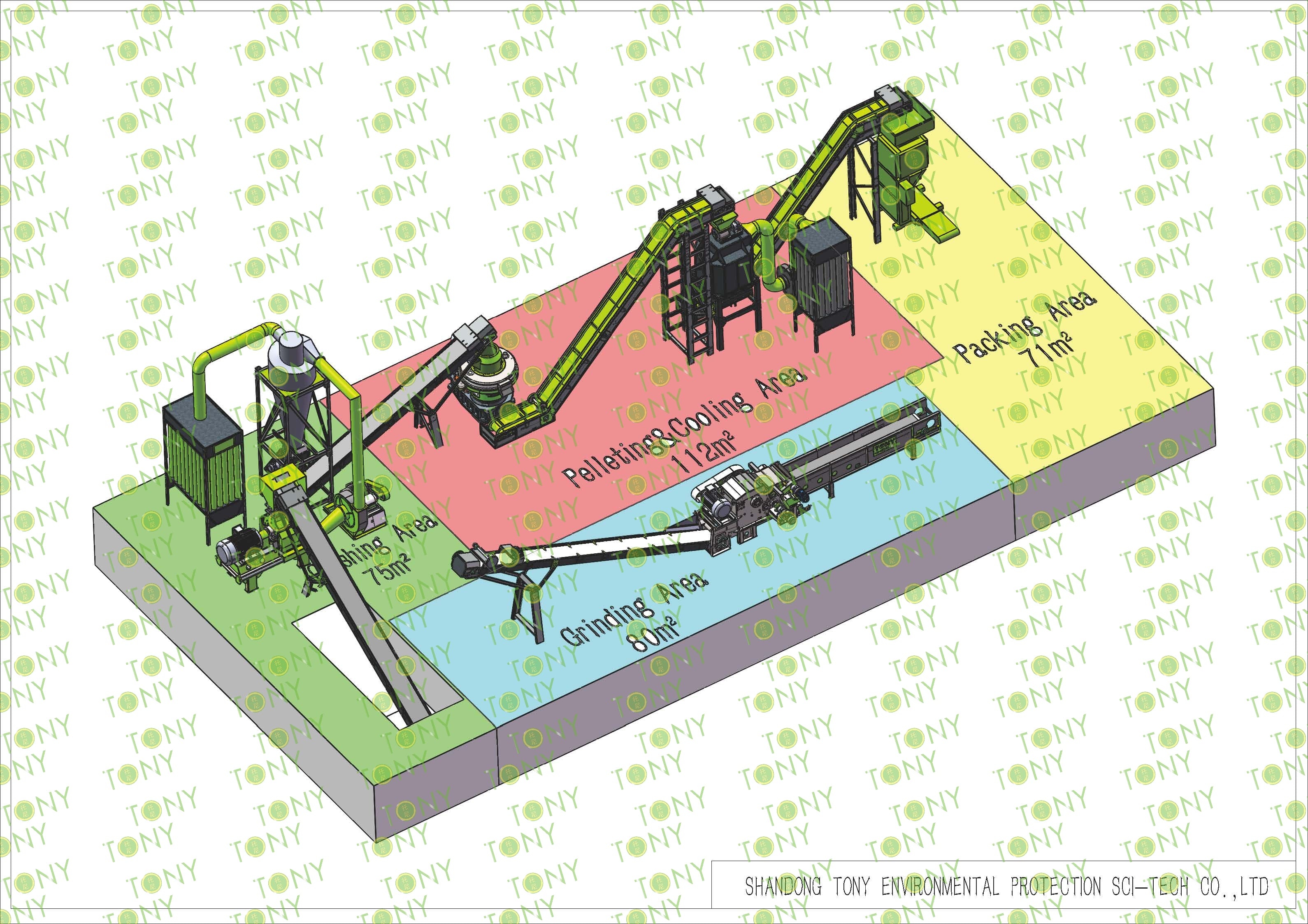
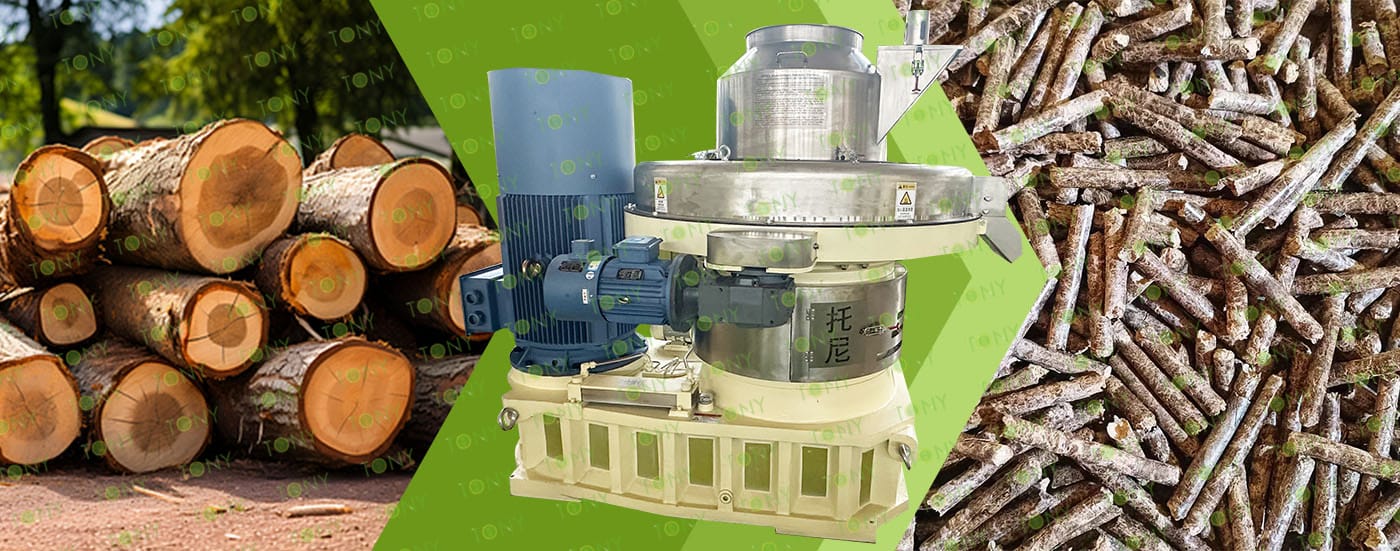
1. The working principle of dried wood log biomass pellet processing equipment
Dry wood biomass pellet processing equipment operates by converting dry wood waste (such as sawdust, shavings, and wood chips) into high-density, regularly shaped biomass pellet fuel through a series of physical processes. This process relies on mechanical extrusion and the natural bonding of lignin, eliminating the need for additional adhesives. The dry wood biomass pellet processing process can be summarized as follows: raw material pretreatment → extrusion molding → post-processing. Because the raw material is "dry wood" (with a moisture content typically controlled at 10%-15%), deep drying is not required. Instead, the process focuses on densifying the material through mechanical force and utilizing the heat generated during processing to activate the bonding properties of lignin, ultimately forming stable pellets.
2. Characteristics of dried wood log biomass pellet processing equipment
Wood pellet processing equipment (i.e., wood biomass pellet machines and supporting production lines) is specifically designed to process wood materials such as sawdust, wood chips, and branches into high-density pellets.
It is compatible with a wide range of wood materials: sawdust, wood chips, shavings, wood chaff, shredded branches, and waste wood. Both softwoods (such as pine and fir) and hardwoods (such as oak and birch) can be efficiently processed after pretreatment (crushing and pulverization).
To address raw material moisture fluctuations: Dedicated drying equipment (such as drum dryers) can control the moisture content of wood raw materials to 10%-15% (the optimal moisture range for wood pellet production), avoiding problems such as clogging and loose pellets caused by excessive moisture.
Flexible particle size control: The accompanying pulverizer can crush wood raw materials to the size of sawdust, meeting the pellet machine's fineness requirements and ensuring uniform pellets.
3. Application scenarios of dried wood log biomass pellet processing equipment
Processing equipment provides fuel for factory boilers and kilns (replacing coal and oil), such as steam boilers in textile and food processing plants, and heating kilns in the ceramics and building materials industries. Stable pellet production ensures a secure energy supply.
Power Generation:
Biomass power plants require large quantities of standardized pellets as fuel. Large-scale processing equipment can meet the power plants' stringent requirements for pellet calorific value and density, ensuring efficient combustion and stable power generation.
Residential Heating:
For pellets used in home fireplaces and space heaters, processing equipment must control pellet size and hardness to accommodate residential combustion equipment. The equipment's refined production capabilities directly impact the user experience of these pellets.

TONY Brand3 Ton/Hour Dried Wood Log Pellet Manufacturing Plant can take dried wood, various types of wood - related biomass materials, such as branches, small - diameter logs, and wood shavings, with dried wood as the main raw material. After pretreatment and processing, it is solidified into high - density wood pellet fuel. This fuel is an ideal substitute for coal and oil and plays a role in energy conservation and emission reduction. At present, it has been widely used in regions rich in wood resources.
1. Capacity: 3 Ton/Hour
2. Raw materials: Dried wood logs , branches, small - diameter logs, twigs, etc.
3. Moisture: Dried type, about 10-15%.
4. Application: All kinds of wood - based biomass materials suitable for pellet production.
Suitable customers: Green energy companies, forestry enterprises, and private wood - processing workshops that have advantages in wood raw materials.
5. Finished Pellets Markets: Large power plants ,domestic heating, industrial heating, combustion heat, heating systems, boiler rooms, school canteens, foundry heat sources.

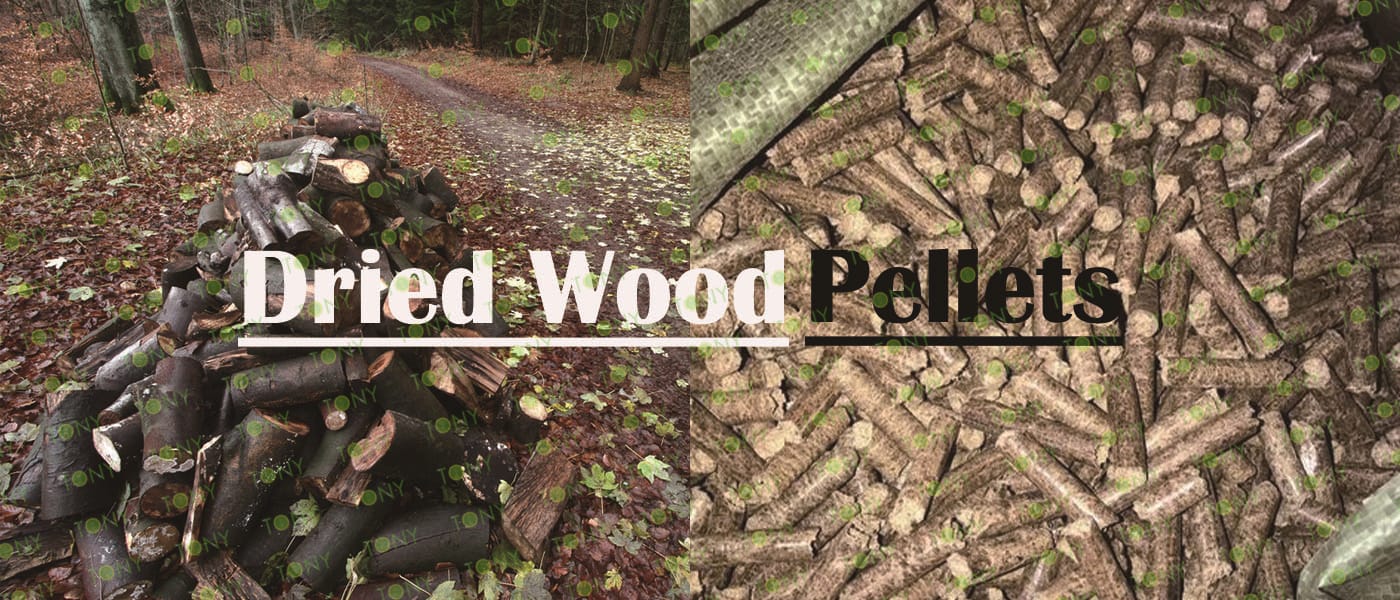
1. Project Name: Dried Wood Log Pellet Production Line
2. Raw Material: All kinds of Dried wood log
3. Moisture Content of Raw Material: 10-15%
4. Capacity: 3 tons per hour
5. Process: Crushing Process - Fine Crushing Process - Pelletizing Process - Cooling Process - Packing Process
6. Main Equipment: Wood Chipper TPQ216 - 55KW, Effective Hammer mill-TFD75*100-90kw, TONY Pellet Machine TYJ760 - Ⅲ - 200kw, Pellet Cooler, Small Packing Machine and Belt Conveyors

|
How to use the TONY pellet production line to make pellets from dried wood log? The process mainly includes the following steps and equipment: 1. Use TONY wood chipper to cut dried wood log with a diameter of less than 20 cm into wood chips 25 - 55 mm in length. 2. Use TONY Effective Hammer mill to crush the 25-55 mm wood chips into 8-14 mm sawdust. 3. Use TONY vertical ring die pellet machine to produce pellets with a diameter of 6-8 mm. 4. Use TONY galvanized cooler to cool the pellets from 80-90°C to 20-30°C. 5. Use TONY semi - automatic packing machine to pack the pellets into bags, each weighing 15-50 kg. For more detailed information and quotations, you can contact TONY. TONY can provide all the above - mentioned products at highly competitive prices and with excellent quality. |
|
|||||||||||||||||||||||||||||||||||||||||||||
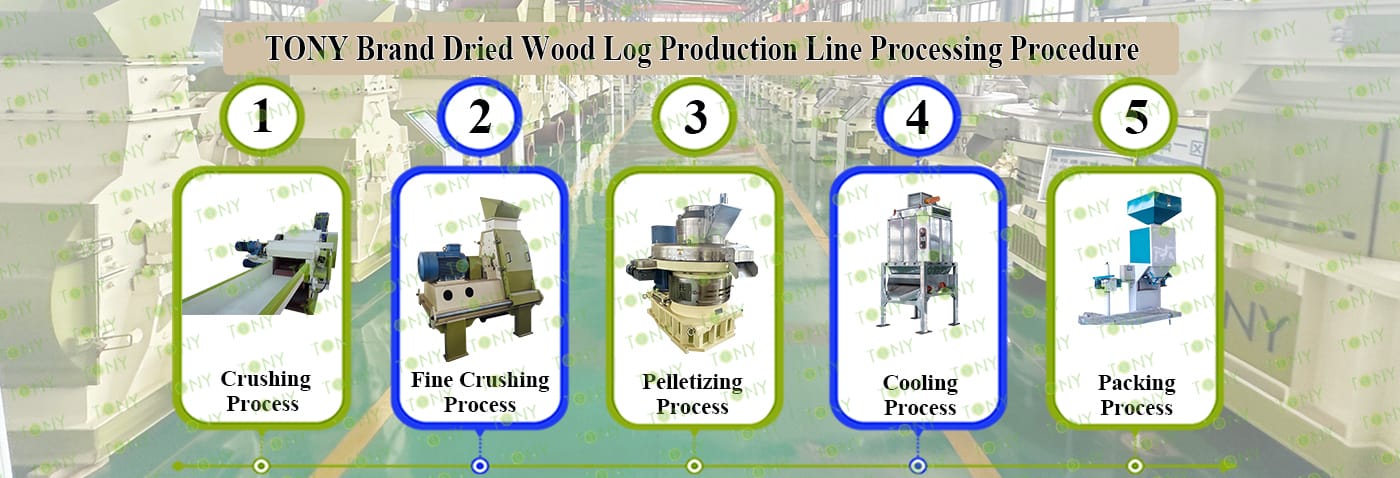
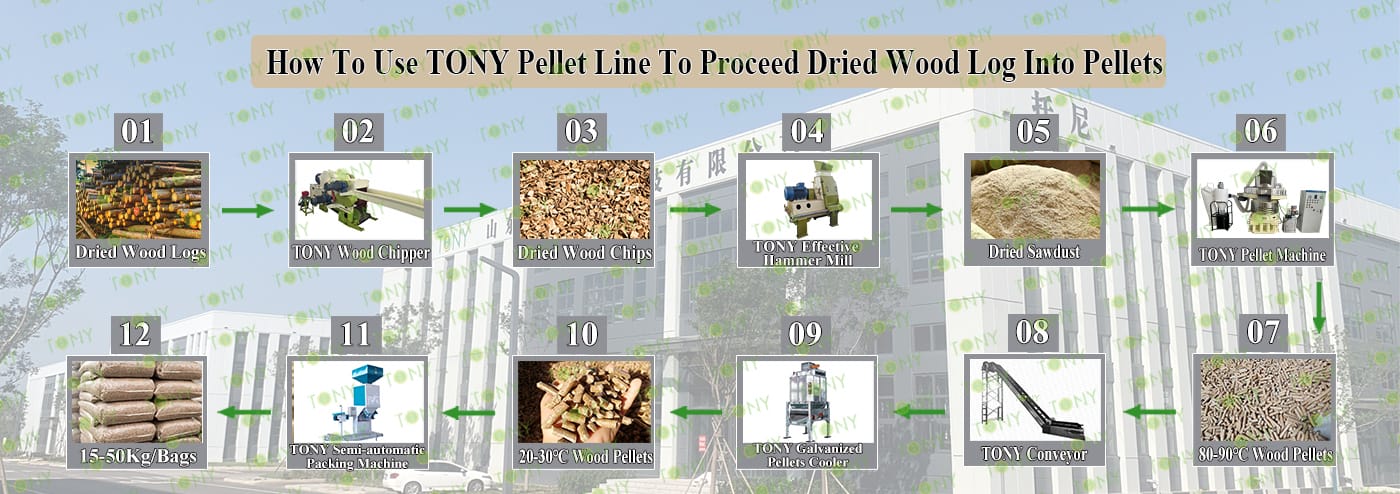



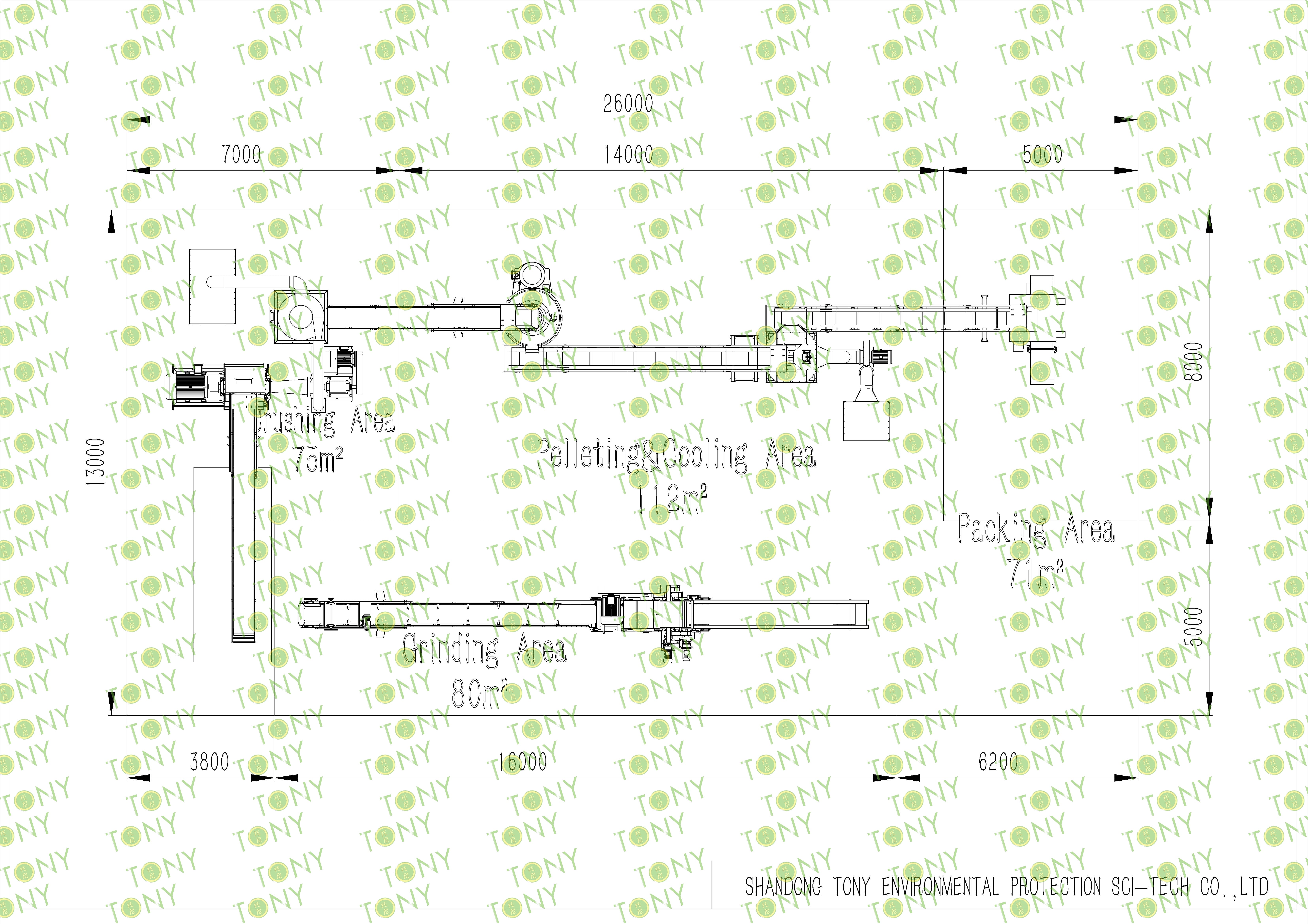

| Next, TONY Will Introduce To You All The Necessary Machinery That Will Be Used For The Whole Pellet Production Line. Some Machines Can Be Custom - Made By Customers According To Different Customers' Detailed Demands. Contact TONY For More Details, Including Quotation And Layout. | ||
 |
 |
 |
| Wood Chipper | Effective Hammer mill | Vertical Ring Die Sawdust Pellet Machine |
| 1.To Grind Wood Logs φ ≤20cm Into25-55mm Wood Chips. 2.Model: TPQ216-55KW With 2 Baldes*1set 3.Capacity: 4-7Ton/Hour. |
1.To Crush 25-55mm Wood Chips Into 8-14mm Sawdust. 2.Model: TFQ75*100-90KW*1set 3.Capacity: 3Ton/Hour/Set |
1.To Press Dry Sawdust Into 6-8mm Biomass Pellets 2.Model: TYJ760-III-200KW*1 Set 3.Capacity:3Ton/Hour/Set 4.New 304SS Type |
 |
 |
 |
| Galvanized Pellets Cooler | Semi-automatic Packing Machine | Belt Conveyor |
| 1.To Cool Pellets From 80-90℃ Into 20-30℃ 2.Model: TCN-1*1set 3.Capacity:3Ton/Hour |
1.To Pack Pellets Into 15-50KG/Bags. 2.Model: TBF-50*1Set 3.Capacity: 3Ton/Hour |
1.To Transport Wood Chips,Sawdust,Pellets. 2.Width: 50cm*4sets 3.Capacity:Designed With The Whole Line |


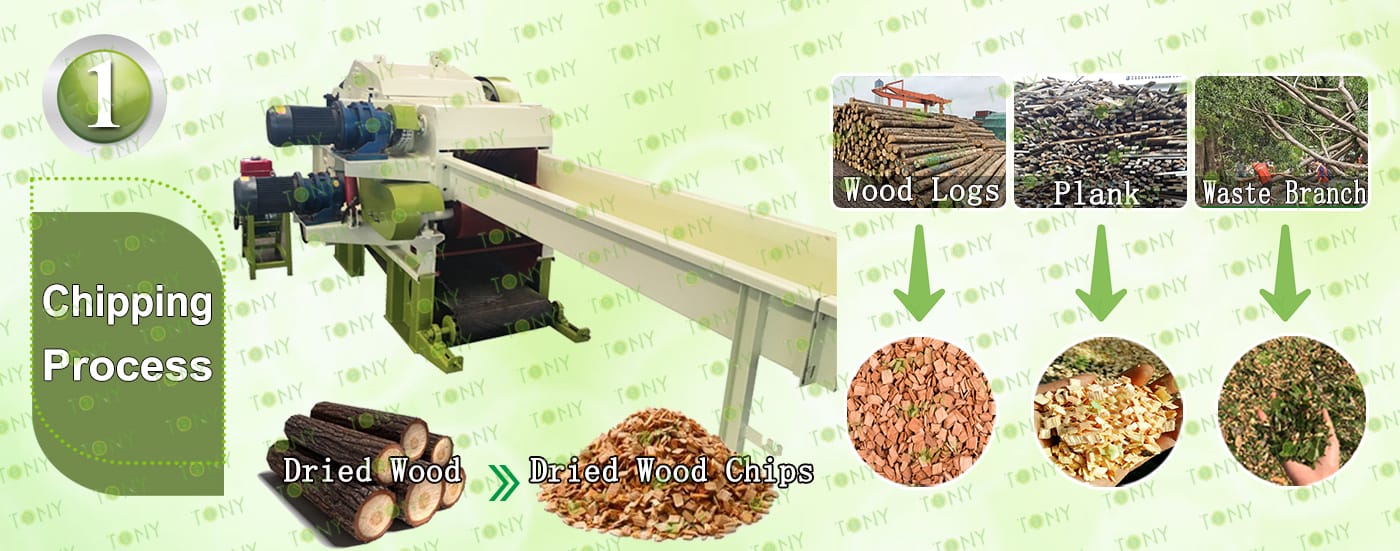
1.Wood Chipping Process:
A.This process is mainly used to grind the wood logs whose diamater is under 20cm into wood chips with size 25-55mm. The finish wood chips size can be adjustable by changing different sizes of screeners and adding flying knives inside the wood chipper.
B.TONY Brand TPQ216 model with 2 flying blades type
C.Capacity:4-7Ton/Hour.
Main Parts:
(1).TONY's Wood Chipper.
(2). Feed And Discharge Belt Frequency Control To Prevent Card Material
(3). Hydraulic System Control Can Be Used For Thicker Materials
(4). Electronic Control System Allows The Equipment To Be Used Normally
Contact Tony For More Details With Quotation


2.Wood Chips Fine Crushing Process:
A.This process is mainly used to crush 25-55mm wood chips into 8-14mm sawdust.
B.Capacity:3Ton/Hour.
C.TONY use Effective Hammer mill TFQ75*100-90KW*1set
Main Parts:
(1).TONY Effective Hammer mill.
(2).Galvanized Dust Collector.
(3).Sawdust Transportation Fan Blower.
(4).Cyclone With Airlock.
(5). Electrical Cabinets.

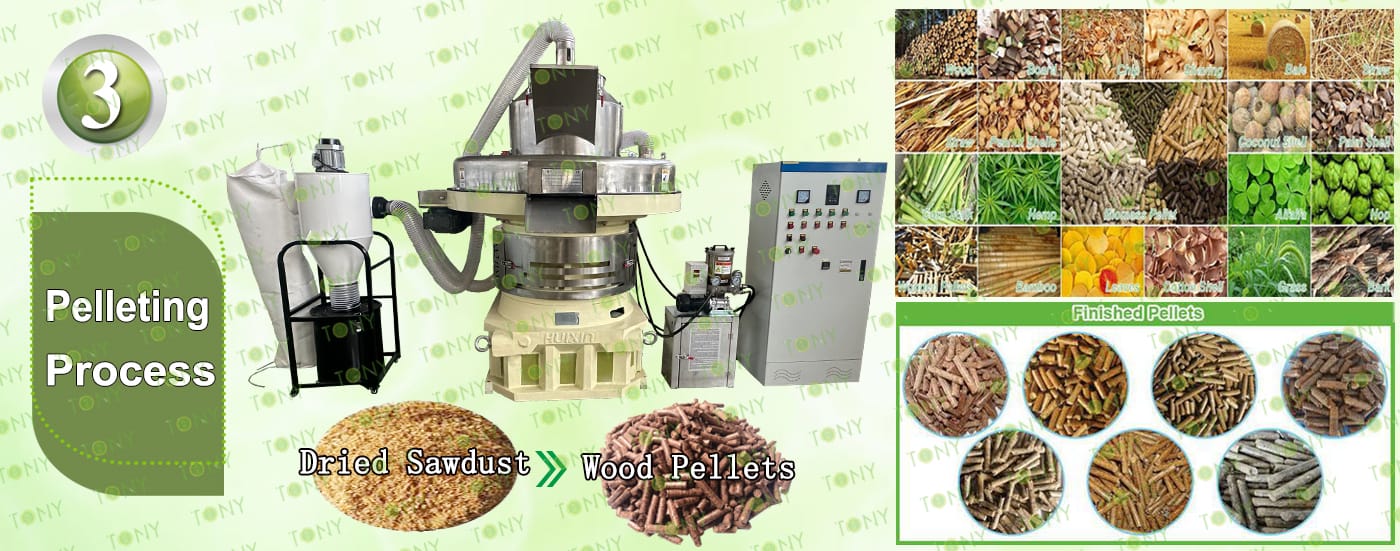
3.Pelletizing Process:
A.This process is mainly used to to product pellets into φ6-8mm.
B.Capacity:3Ton/Hour.
C.TONY Brand Vertical Ring Die Pellet Machine TYJ760-III-200KW
Main Parts:
(1).TONY's New Vertical Ring Die Pellet Machine.
(2).Cyclone And Bags Dust Collectors.
(3).Automatic Lubrication System.
(4).Electrical Cabinets.
You can chose TONY new type SS304 pellet machine

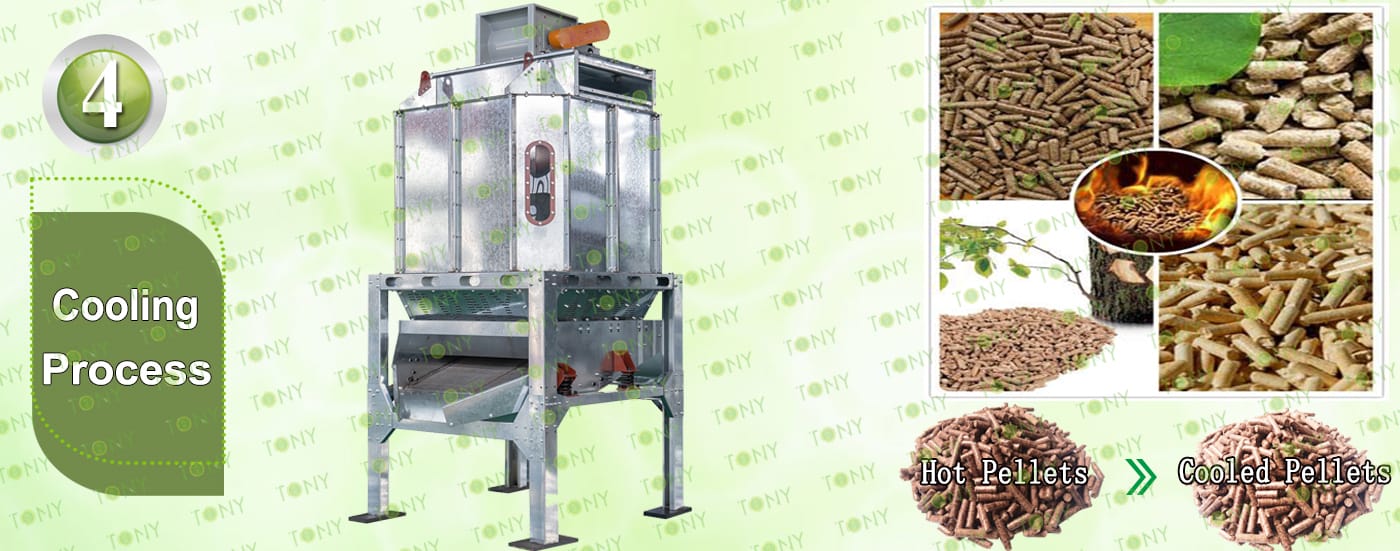
4.Cooling Process:
A.This process is mainly used to cool pellets from 80-90℃ to 20-30℃
B.1Set Of TONY Galvanized Cooler Seperator With Capacity3Ton/Hour
Main Parts:
(1).TONY's Galvanized Cooler Seperator With Vibrating Screen.
(2).Cyclone And Bags Dust Collectors.
(3).Fan Blower.
(4).Connect Pipes.

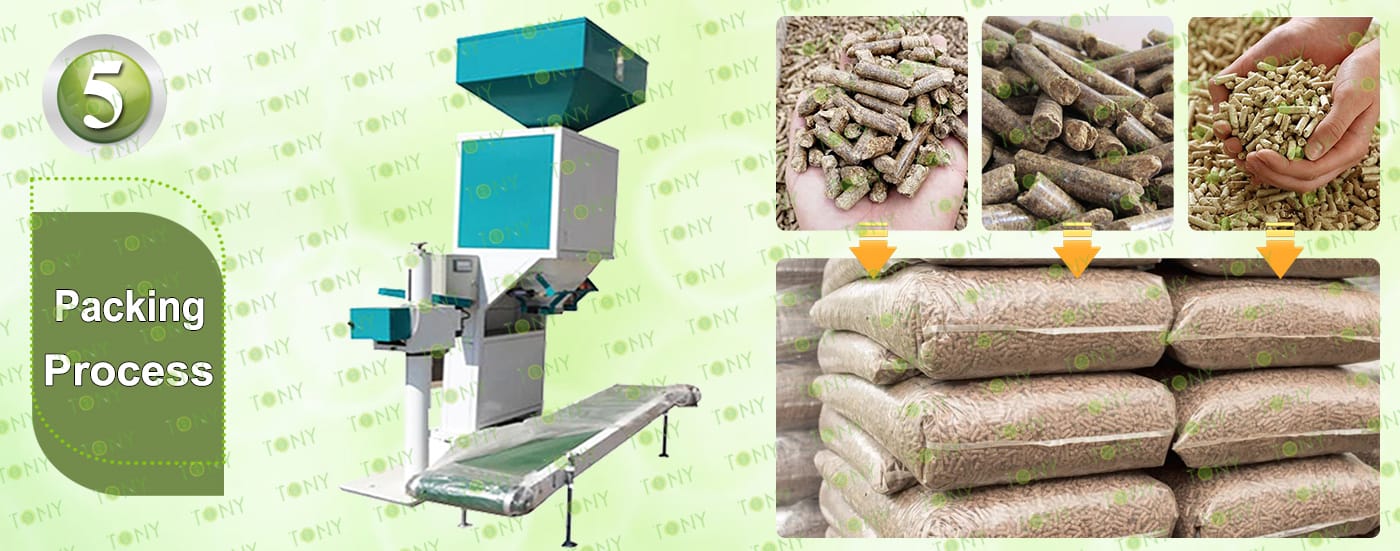
5.Packing Process:
A.This process is mainly used to pack pellets into 15-50KG/Bags.
B.1 Set of TONY Semi-Automatic Packing Machine.
Main Parts:
(1).TONY's Semi-Automatic Packing Machine.
(2).Sew Machine, Buyer Can Also Choose Hot Seal Machine For Chosen,To Confirm With Tony For The Price Difference.
(3).Bags Transportation Conveyors.
(4).Feeding Inlet Silo.
(5).Electrical Cabinets.

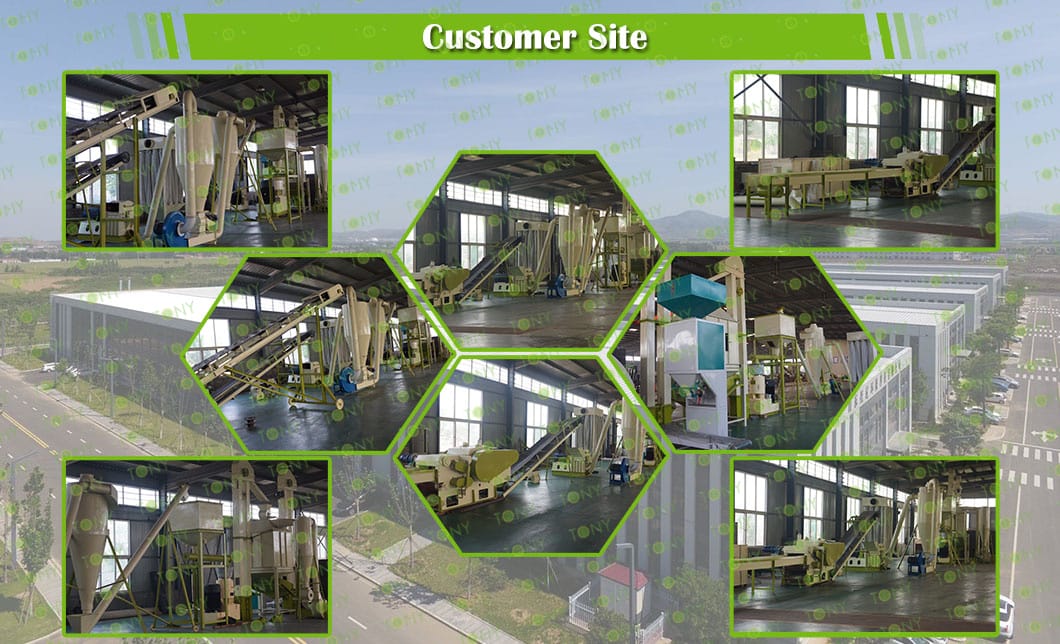

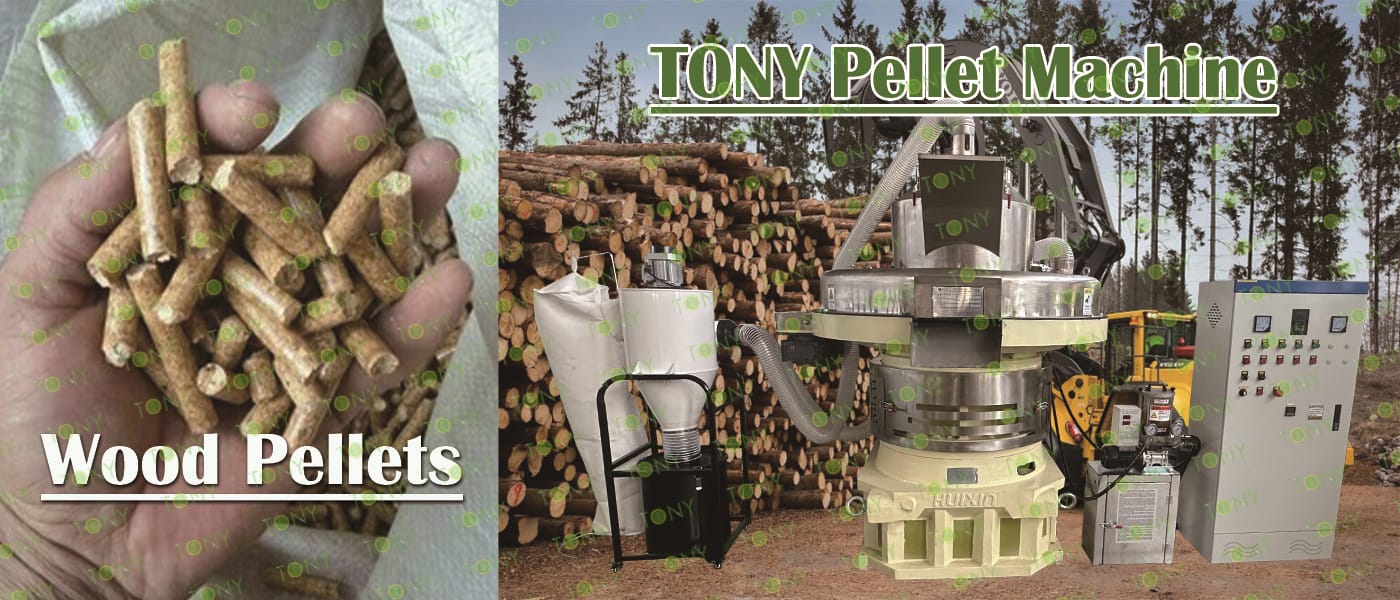
Investors should prioritize regions with abundant raw materials and strong policy support. By securing raw material supplies, improving production capacity utilization, and expanding into high-end markets (such as export and consumer applications), they can further shorten their payback period and achieve rapid returns.
The investment costs of dry wood pellet processing include the following:
1. Equipment Investment:
Equipment investment varies depending on the project scale and the equipment selected. A small semi-automated production line may cost only tens to hundreds of thousands of yuan, while a large fully automated production line can cost millions or more.
2. Building and Site Costs:
You need to select appropriate building and site based on your production scale. Rent or construction costs vary by region.
3. Raw Material Procurement and Transportation Costs:
Raw material costs are affected by factors such as region, season, and raw material type, while transportation costs are related to the raw material sourcing radius and product sales range.
4. Environmental and Other Expenses:
This includes the investment and operating costs of environmental protection equipment, utilities, and employee salaries.


1. Outstanding Environmental Protection and Low Carbon Emissions
Carbon Neutral: Wood pellet fuel is derived from wood processing waste (such as wood chips and sawdust) and is a biomass energy source. The carbon dioxide absorbed during plant growth is roughly balanced by the carbon dioxide released during combustion, making it a "carbon-neutral" energy source, significantly reducing its contribution to the greenhouse effect.
Low Pollutant Emissions: Compared to coal, wood pellets produce extremely low levels of pollutants such as sulfur dioxide and nitrogen oxides (often far below environmental standards) when burned, and dust emissions are also low, effectively reducing air pollution and meeting increasingly stringent environmental regulations.
2. Wide Source of Raw Materials and Controllable Costs
Abundant Raw Materials: The main raw materials are scraps, wood chips, sawdust, branches, and bark generated during wood processing. These materials are readily available and stable in forestry, furniture manufacturing, and papermaking. They can even be "turned waste into treasure," reducing the environmental impact of landfills or incineration. Cost Advantages: The raw materials are mostly industrial waste, resulting in relatively low procurement costs. Furthermore, some regions offer subsidies for biomass energy projects, further reducing production and usage costs. Compared to other energy sources like natural gas and fuel oil, biomass energy is economical.
3. High Combustion Efficiency and Efficient Energy Utilization
High Density: Wood pellets are compressed and formed, resulting in a density significantly higher than that of raw wood or sawdust (typically 1.1-1.3 tons/cubic meter). They are less prone to loosening during combustion, maintaining a stable combustion state and a long-lasting flame. They also offer high thermal efficiency (typically exceeding 85%, compared to the 40%-50% of loose firewood).
Stable Combustion: The pellets have a regular shape and uniform size, facilitating automated feeding and combustion control. They can be precisely adjusted with a matching pellet stove, reducing energy waste and making them suitable for applications requiring a stable heat source.
4. Convenient Storage and Transportation
Small Size: Compressed pellets are only 1/5-1/8 the volume of raw sawdust, significantly saving storage space. They can be stored in bags or in bulk, eliminating the need for specialized storage facilities, making them suitable for homes, businesses, and other environments. Low Transportation Costs: The high density allows for higher energy transport per unit volume, improving transportation efficiency and reducing transportation costs. Furthermore, the pellets are resistant to moisture (some products are treated to prevent moisture), minimizing loss during transportation.
5. Diverse Application Scenarios
Civilian Applications: They can be used for home heating and cooking (using devices such as pellet fireplaces and pellet stoves). They are simple and clean to operate, replacing traditional coal and firewood to improve the indoor environment.
Industrial Applications: They can be used as boiler fuel to provide steam or hot water for factories, hotels, and hospitals. In agriculture, they can be used for greenhouse heating and drying agricultural products (such as grains and medicinal herbs).
Power Generation: They can be used as fuel in biomass power plants, either mixed with coal or burned alone to generate electricity, contributing to the transformation of the energy structure.



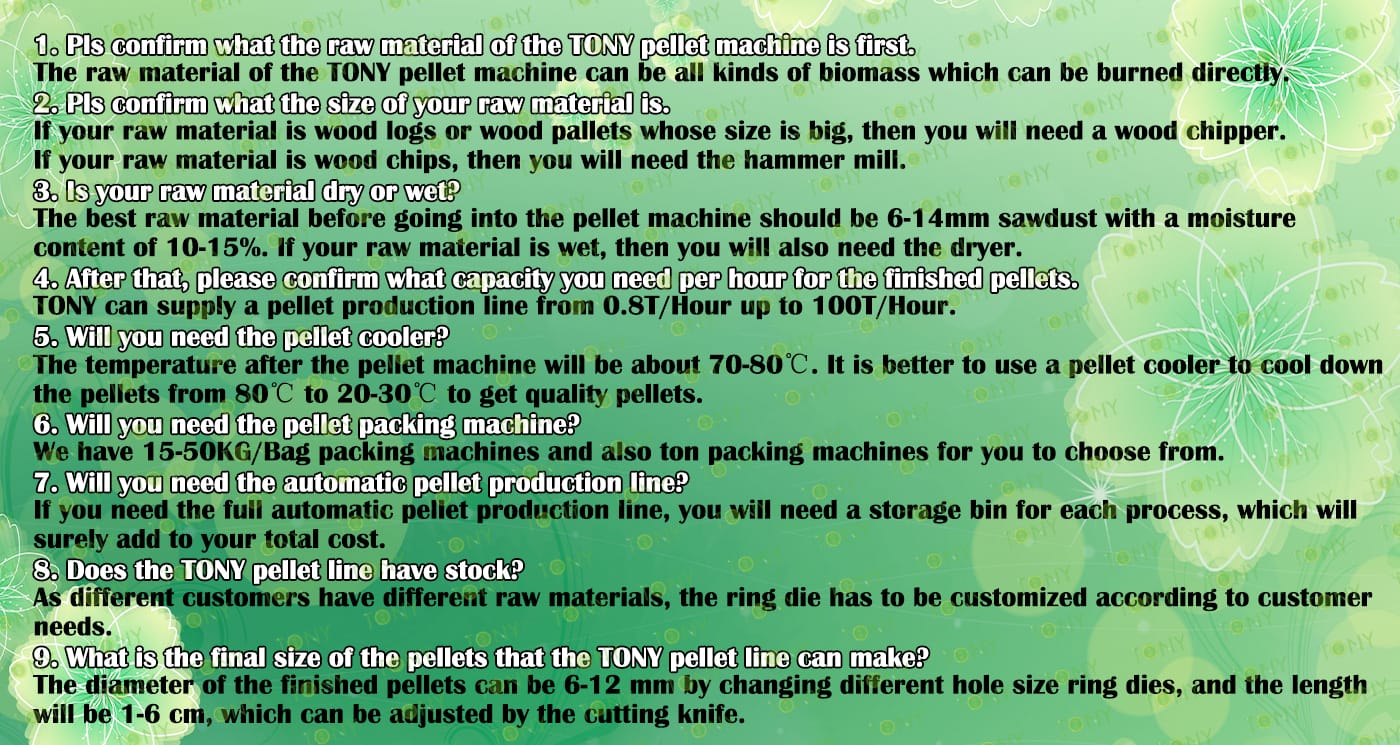


2025 Tony Machinery - All Rights Reserved. Map